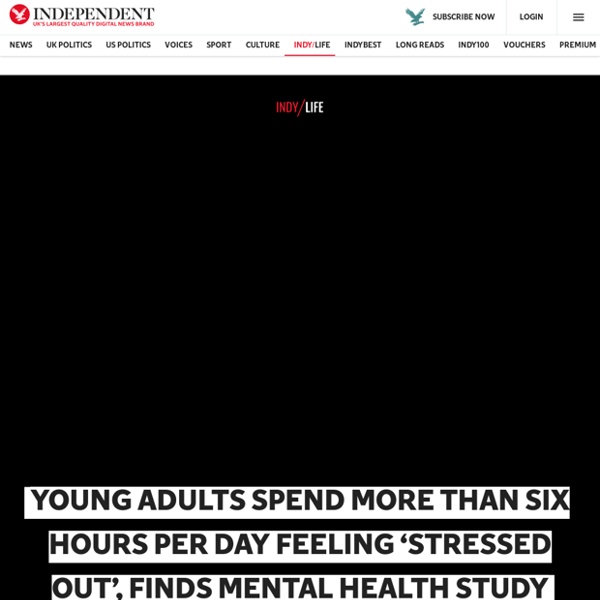The Most Stressed-Out Generation? Young Adults
The latest survey shows stress is on the decline overall but still hover above healthy levels, especially for young adults. In the national Stress in America survey, an annual analysis by Harris Interactive for the American Psychological Association, 35% of adults polled since 2007 reported feeling more stress this year compared with last year, and 53% said they received little or no support from their health care providers in coping with that heightened stress. The survey involved more than 2,000 U.S. adults ages 18 and older who answered an online survey in August 2012. The participants ranked their overall stress level on a scale of 1 to 10, with 1 being “little or no stress” and 10 being “a great deal of stress.” Overall, stress in the U.S. has been declining since 2010, when 24% of Americans reported experiencing extreme stress compared with 20% in 2012.
Can We Become Addicted to Stress?
In 2011, Americans rated their personal stress levels an average of 5.2 out of 10. And 22% admitted to being under extreme stress on a regular basis. Gulp! Stress can be physical, like what we subject our muscles to at the gym. And then there’s the kind that’s in our heads — that OMG I’m so overwhelmed right now feeling. While psychological stress has some definite downsides (chronic freak-outs may increase our risk for cancer and other diseases), take a moment to exhale.
11 Signs and Symptoms of Too Much Stress
Stress is defined as a state of mental or emotional strain caused by adverse circumstances. At one point or another, most people deal with feelings of stress. In fact, one study found that 33% of adults reported experiencing high levels of perceived stress (). The condition is associated with a long list of physical and mental symptoms.
Young Adults Are America's Most Stressed Generation: Survey – WebMD
THURSDAY, Feb. 7 (HealthDay News) -- Young Americans between 18 and 33 years old -- the so-called millennials -- are more stressed than the rest of the population, according to a new report from the American Psychological Association. What's stressing them out? Jobs and money mostly, said Norman Anderson, CEO of the American Psychological Association, during a Thursday morning press conference. On a scale of 1 to 10, the millennial generation stands at 5.4 stress-wise, significantly higher than the national average of 4.9, the association found after surveying more than 2,000 Americans.
Teen Stress Is on the Rise: Why It's a Major Problem, and How You Can Help
Manage Push Notifications If you have opted in for our browser push notifications, and you would like to opt-out, please refer to the following instructions depending on your device and browser. For turning notifications on or off on Google Chrome and Android click here, for Firefox click here, for Safari click here and for Microsoft's Edge click here. Manage Push Notifications If you have opted in for our browser push notifications, and you would like to opt-out, please refer to the following instructions depending on your device and browser. For turning notifications on or off on Google Chrome and Android click here, for Firefox click here, for Safari click here and for Microsoft's Edge click here.
How FOMO Impacts Teens and Young Adults
"You totally missed out!" This sentence strikes fear in the hearts of teens more than almost anything else you can say to them. In fact, missing out on something bothers most teens so much there is even a special word for that sick feeling they get in the pits of their stomachs: FOMO. What Is FOMO? In simple terms, FOMO stands for "fear of missing out."
The biggest cause of stress in America today
Money continues to be the leading cause of stress for Americans, a new survey finds. Overall, stress in the United States is at a seven-year low, and average stress levels are declining, the American Psychological Association poll found. But money worries continue to nag at the American psyche, despite the ongoing economic recovery, the association says in its report released Feb. 4, titled Stress in America: Paying With Our Health. Financial worries served as a significant source of stress for 64 percent of adults in 2014, ranking higher than three other major sources of stress: work (60 percent), family responsibilities (47 percent), and health concerns (46 percent).
The ‘storm and stress’ of adolescence and young adulthood - Counseling Today
For much of human history, the idea of adolescence being a distinct life stage was nonexistent. True, in the Middle Ages, children were recognized not merely as “mini” adults but as distinct beings with different needs. However, the years from ages 13 to 19 were not considered part of childhood until the turn of the 19th century. Instead, the “teen years” were the time when one began to assume adult responsibilities such as making a living and starting a family. During the late 1800s, changes in child labor laws and the push for universal education for those under the age of 16 began to influence society’s perspective on when adulthood began.



